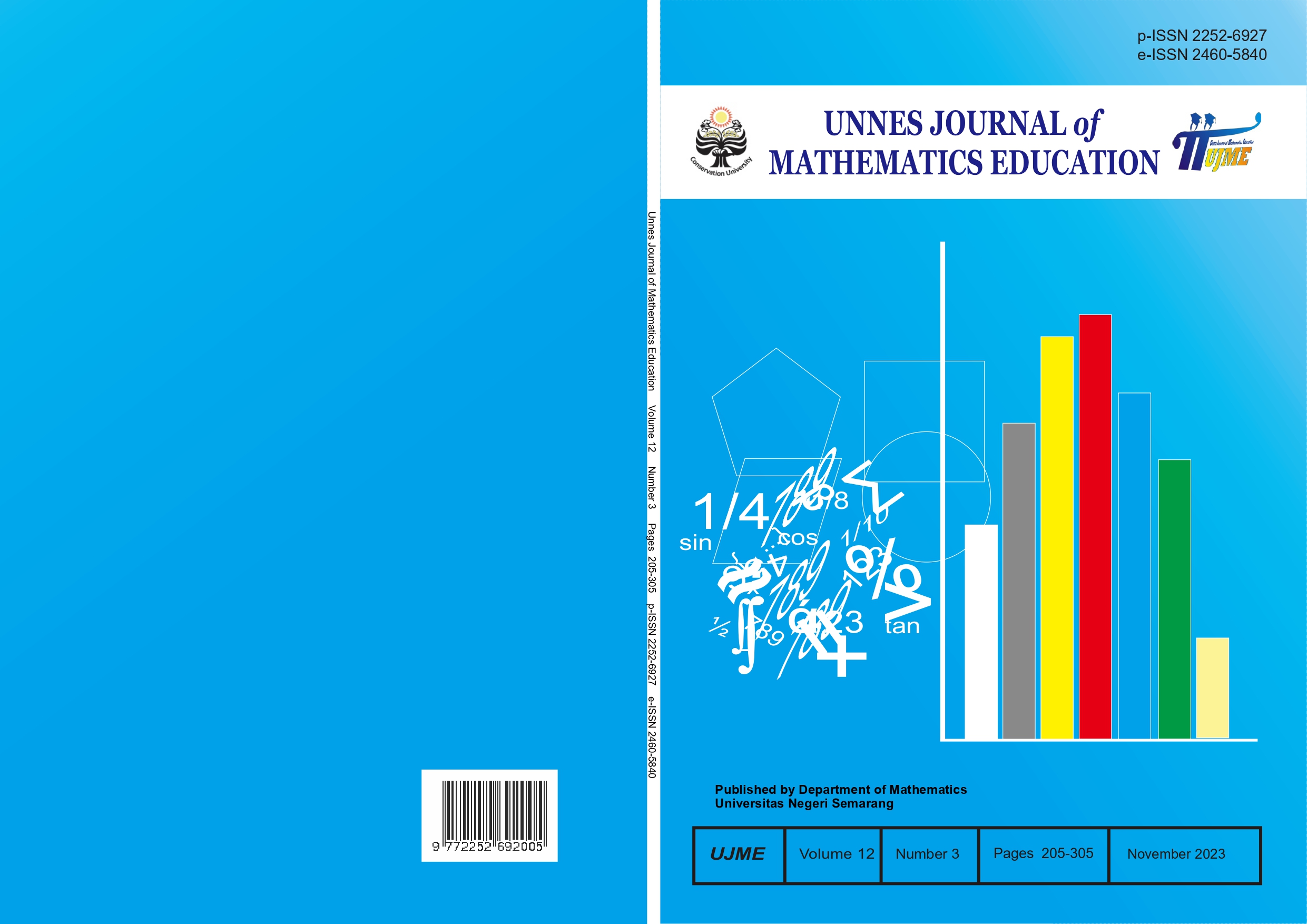Students' Mathematical Problem-Solving Ability Based on Cognitive Style in Flipped Classroom Learning Model Assisted by Sevima Edlink
##plugins.themes.academic_pro.article.main##
Abstract
This research aims were to (1) test the effectiveness of the Flipped Classroom learning model assisted by the Sevima Edlink on students' mathematical problem-solving abilities, and (2) describe students' mathematical problem-solving abilities based on cognitive style in the Flipped Classroom learning model assisted by the Sevima Edlink. This research was a mixed methods type of sequential explanatory design. Quantitative methods were used to test the effectiveness of using the Flipped Classroom learning model on students' mathematical problem-solving abilities while qualitative methods were used to describe students' mathematical problem-solving abilities based on cognitive style in the Flipped Classroom learning model assisted by the Sevima Edlink. Data collection was carried out using problem-solving ability tests, GEFT tests (cognitive style tests), and interviews. The population of this study were all class VIII students of SMP N 1 Pecangaan for the 2022/2023 school year. The samples used were students of class VIII E as the experimental group and class VIII G as the control group. The results of the research conducted showed that (1) the Flipped Classroom learning model was effective in increasing students' mathematical problem-solving abilities, (2) students' mathematical problem-solving abilities in terms of cognitive style were divided into two categories, namely FI (7) and FD (15). The FI category is divided into 3 patterns of problem-solving abilities while students with the FD category are divided into 5 patterns.
##plugins.themes.academic_pro.article.details##
References
Ariyani, W., Suyitno, H., & Junaedi, I. (2020). Mathematical Connection Ability And Students’ Independence in Missouri Mathematics Project E-Learning. Unnes Journal of Mathematics Education Research, 9(2), 2020–2185. http://journal.unnes.ac.id/sju/index.php/ujmer
Asad, M., Athar, R., Churi, P., & Moreno-Guerrero, A. J. (2022). Impact of Flipped Classroom Approach on Students’ Learning in Post-Pandemic: A Survey Research on Public Sector Schools. Education Research International, 2022. https://doi.org/10.1155/2022/1134432.
Bergmann, J., & Sams, A. (2012). Flip your classroom : reach every student in every class every day (1 ed.). iSTE. ASCD.
Davita, P. W. C., & Pujiastuti, H. (2020). Anallisis Kemampuan Pemecahan Masalah Matematika Ditinjau Dari Gender. Jurnal Matematika Kreatif-Inovatif, 11(1), 110–117. https://doi.org/10.15294/kreano.v11i1.23601.
Firdausi, M., Inganah, S., & Rosyadi, A. A. P. (2018). Kemampuan koneksi matematis siswa sekolah menengah pertama berdasarkan gaya kognitif. Jurnal Matematika Dan Pembelajaran, 6(2), 237–249.
Harahap, E. R., & Surya, E. (2017). Kemampuan Pemecahan Masalah Matematis Siswa Kelas VII dalam Menyelesaikan Persamaan Linear Satu Variabel. Edumatica, 07(1), 44–54.
Kirisci, N., Sak, U., & Karabacak, F. (2020). The effectiveness of the selective problem-solving model on students’ mathematical creativity: A Solomon four-group research. Thinking Skills and Creativity, 38, 100719. https://doi.org/10.1016/j.tsc.2020.100719.
Lutfiyah, L., & Sulisawati, D. N. (2019). Efektivitas Pembelajaran Matematika Menggunakan Media Berbasis E-Learning. Jurnal Pendidikan Matematika, 2(1), 58–65. https://doi.org/10.31539/judika.v2i1.716
Marlissa, I., & Widjajanti, D. B. (2015). Pengaruh Strategi REACT Ditinjau Dari Gaya Kognitif Terhadap Kemampuan Pemecahan Masalah, Prestasi Belajar dan Apresiasi Siswa Terhadap Matematika. Jurnal Riset Pendidikan Matematika. 2(2), 186–196.
Mauleto, K. (2019). Analisis Kemampuan Pemecahan Masalah Ditinjau dari Indikator NCTM dan Aspek Berpikir Kritis Matematis Siswa di Kelas 7B SMP Kanisius Kalasan. Jurnal Ilmiah Pendidikan Matematika, 4(2), 125–134.
Mawaddah, S., & Hana, A. (2015). Kemampuan Pemecahan Masalah Matematis Siswa pada Pembelajaran Matematika dengan Menggunakan Model Pembelajaran Generatif di SMP. Jurnal Pendidikan Matematika, 3(2), 166–175.
NCTM. (2000). Principles and Standards for School Matematics.
OECD. (2018). Programme of International Student Assesment (PISA) Result. OECD. https://doi.org/https://doi.org/https://doi.org/10.1787/5f07c754.
Phonapichat, P., Wongwanich, S., & Sujiva, S. (2014). An Analysis of Elementary School Students’ Difficulties in Mathematical Problem Solving. Procedia - Social and Behavioral Sciences, 116, 3169–3174. https://doi.org/10.1016/j.sbspro.2014.01.728.
Polya, G. (1988). How to Solve It (1 ed.). Princeton Science Library.
Prabawa, E. A. (2017). Analisis Kemampuan Pemecahan Masalah Ditinjau Dari Gaya Kognitif Siswa pada Model Project Based Learning Bernuansa Etnomatematika. 6(1), 120–129.
Pradiarti, R. A., & Subanji. (2022). Kemampuan Pemecahan Masalah Matematis Siswa SMP ditinjau dari Gaya Kognitif. Mosharafa : Jurnal Pendidikan Matematika. 11(3), 379–390.
Rastegar, M., & Honarmand, N. M. (2016). Field Dependence / Independence , Impulsivity / Reflectivity , Gender , and Cloze Test Performance of Iranian EFL Learners : A Study of Relations. European Scientific Journal March, 12(8), 408–422. https://doi.org/10.19044/esj.2016.v12n8p408
Sumartini, T. S. (2016). Peningkatan Kemampuan Pemecahan Masalah Matematis Siswa melalui Pembelajaran Berbasis Masalah. Jurnal Pendidikan Matematika STKIP Garut, 5(2), 148–158. http://e-mosharafa.org/
Susanti, L., & Hamama Pitra, D. (2019). Flipped ClassroomSebagai Strategi Pembelajaran Pada Era Digital. Health & Medical Journal, 1(2), 54–58.
Sutama, Anif, S., Prayitno, H. J., Narimo, S., Fuadi, D., & Sari, D. P. (2021). Metacognition of Junior High School Students in Mathematics Problem Solving Based on Cognitive Style. Asian Journal of University Education (AJUE), 17(1), 134–144.
Ulya. (2015). Hubungan Gaya Kognitif Dengan Kemampuan Pemecahan Masalah Matematika Siswa. Jurnal Konseling Gusjigang. 1(2).
Youngchim, P., Pasiphol, S., & Sujiva, S. (2015). Development of a Mathematical Problem-Solving Diagnostic Method: An Application of Bayesian Networks and Multidimensional item Respond Theory. Procedia - Social and Behavioral Sciences, 191, 742–747. https://doi.org/10.1016/j.sbspro.2015.04.497
